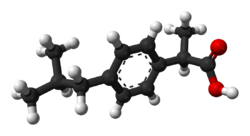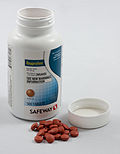Ibuprofen
Ibuprofen is a non-steroidal anti-inflammatory drug (NSAID) created by British chemist Stewart Adams. It is used to stop pain, help reduce fevers, relieve arthritis pain, and helps reduce inflammation. Ibuprofen is used to relieve pain from various conditions such as headache, dental pain, menstrual cramps, muscle aches, or arthritis. It is also used to reduce fever and to relieve minor aches and pain due to the common cold. If it is being taken to treat a chronic condition such as arthritis, a doctor should be asked about non-drug treatments and/or using other medications to treat pain. See also Warning section.
Check the ingredients on the label even if the same or similar product has been used before. The manufacturer may have changed the ingredients. Also, products with similar names may contain different ingredients meant for different purposes. Taking the wrong product could cause harm. When taking over-the-counter products, it is best to read all directions on the product package before taking this medication[verification needed]. If a doctor has prescribed this medication, the Medication Guide provided by a pharmacist should be read before starting ibuprofen and each time the prescription is refilled. Questions should be directed towards a doctor or pharmacist.
The medication is taken by mouth, usually every 4 to 6 hours with a full glass of water (8 ounces/240 milliliters) unless the doctor directs someone otherwise. It is not safe to lie down for at least 10 minutes after taking this drug. If stomach upsets happen while taking the medication, then it can be taken with food, milk, or an antacid.
The dosage is based on the medical condition it is supposed to treat, and response to treatment. To reduce the risk of stomach bleeding and other side effects, taking the medication at the lowest effective dose for the shortest possible time is recommended[verification needed]. The dose or how often the drug is taken being more than what is directed by a doctor or the package label is not recommended[verification needed] and can cause harm.
When ibuprofen is used by children, the dose is based on the child's weight. The package directions to find the proper dose for a child's weight should include this information. The pharmacist or doctor should be consulted if there are any questions or if help is needed in choosing a nonprescription product.
For certain conditions (such as arthritis), it may take up to two weeks of taking this drug regularly before getting the full benefit.
Taking the drug "as needed" (not on a regular schedule), it should be remembered that pain medications work best if they are used as the first signs of pain occur. Waiting until the pain has worsened may cause the medication to not work as well.
If a condition persists or worsens, or if there may be a serious medical problem, see a doctor. If a nonprescription product is being used to treat fever or pain, a doctor should be consulted right away if fever worsens or lasts more than 3 days, or if pain worsens or lasts more than 10 days.
Ibuprofen Media
Ball-and-stick model of the (S)-ibuprofen molecule, based on neutron diffraction data from N. Shankland, C. C. Wilson, A. J. Florence and P. J. Cox (1997). "Refinement of Ibuprofen at 100K by Single-Crystal Pulsed Neutron Diffraction". Acta Crystallographica Section C 53: 951-954. DOI:10.1107/S0108270197003193.
Related pages
References
- ↑ Davanzo, R; Bua, J; Paloni, G; Facchina, G (November 2014). "Breastfeeding and migraine drugs". European Journal of Clinical Pharmacology (Review). 70 (11): 1313–24. doi:10.1007/s00228-014-1748-0. PMID 25217187. S2CID 17144030.
- ↑ 2.0 2.1 2.2 Davies, NM (February 1998). "Clinical pharmacokinetics of ibuprofen. The first 30 years". Clinical Pharmacokinetics. 34 (2): 101–54. doi:10.2165/00003088-199834020-00002. PMID 9515184. S2CID 1186212.
- ↑ Grosser, T; Ricciotti, E; FitzGerald, GA (August 2017). "The Cardiovascular Pharmacology of Nonsteroidal Anti-Inflammatory Drugs". Trends in Pharmacological Sciences (Review). 38 (8): 733–48. doi:10.1016/j.tips.2017.05.008. PMC 5676556. PMID 28651847.
- ↑ "Brufen Tablets And Syrup" (PDF). Therapeutic Goods Administration. 31 July 2012. Archived from the original on 20 August 2016. Retrieved 8 May 2014.







